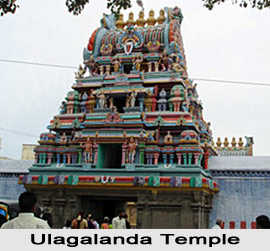 The inscriptions endowed the temple with a historical significance. The antiquity of the temple of Sri Ulagalanda is emphasized by the inscriptions engraved on the temple walls. As the historical researches relate, there are approximately fifteen historical inscriptions engraved on this temple wall. These records of the inscriptions which date from as early as the 9th century A.D reveal that the kings and the common people alike made beneficial contribution to the upkeep of this shrine which was a seat of religious activity in the Pallava, Pandyas and Chola times and also in the subsequent ages.
The inscriptions endowed the temple with a historical significance. The antiquity of the temple of Sri Ulagalanda is emphasized by the inscriptions engraved on the temple walls. As the historical researches relate, there are approximately fifteen historical inscriptions engraved on this temple wall. These records of the inscriptions which date from as early as the 9th century A.D reveal that the kings and the common people alike made beneficial contribution to the upkeep of this shrine which was a seat of religious activity in the Pallava, Pandyas and Chola times and also in the subsequent ages.
The most ancient of these inscriptions is dated 864 A.D and belongs to the Pallava period as the historical researches reveal. From these earliest inscriptions it is recorded that a royal grant was made to this temple in the reign of Nandivarman III (847-862 A.D.). There are also found some Chola inscriptions, one of which is dated 1110 A.D. the historians opined that it belongs to the reign of Kulottunga Chola (1071-1122A.D.). It mentions that this king visited this temple along with his queen and gifted land to this shrine, the income from which was to be used for offerings and worship. Apart from these the Chola king Kulottunga also made some beneficial contribution to this temple.
Another inscription of this king of the same date states that he made a tax-free gift of a village at the request of his queen Kampamadeviyar. It is also recorded from this inscriptions that the income from that village was to be used for conducting certain festivals in this temple. There are other similar inscriptions of the time of the later Cholas, which are also visible in the temple walls. These inscriptions belong to the significant Chola kings like Rajadhiraja I (c.l 163-1182 A.D.) and Rajaraja III (1216-1250 A.D.) and many minor chieftains like Vijaya Gandagopala. The inscriptions referred to the various gifts made by these chieftains to the this temple. It is interesting to note that over the centuries the main deity here has been referred to by numerous names like Tiru Uragattu-Ninrarulina Paramasvamin, Tiru Uragattazhvar and Tiru Uragattu -Emberuman etc. Thus the inscriptions provide not only the information of the contributions made by the kings but also points to the chronological sequence of the different shrines in the temple and the main sanctum itself.





















